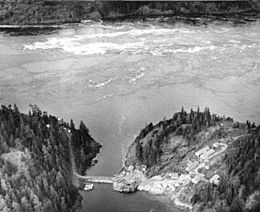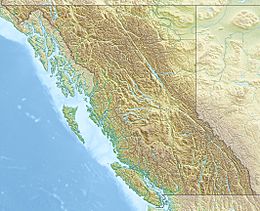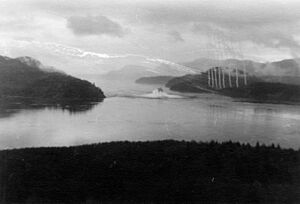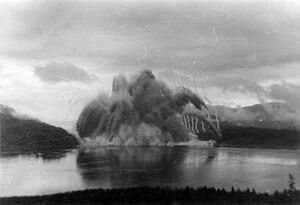Ripple Rock facts for kids
Quick facts for kids Ripple Rock |
|
|---|---|

Aerial view of Ripple Rock in 1957. Note the large, turbulent eddies that formed in its wake during low tide.
|
|
| Location | Seymour Narrows, British Columbia, Canada |
| Coordinates | 50°08′0″N 125°21′0″W / 50.13333°N 125.35000°W |
| Geology | Seamount |
Ripple Rock (which means Ripple Stone in French) was an underwater mountain in British Columbia, Canada. It was located in a narrow waterway called the Seymour Narrows. This rock had two peaks that were very close to the water's surface.
These peaks caused strong, dangerous swirling currents called eddies. Ships had to wait for the water to be calm, known as slack tide, to pass safely. Because it was so dangerous, the Canadian government decided to blow up the top of Ripple Rock.
This huge explosion happened on April 5, 1958. It was shown live on television across Canada. This made it one of the first big events broadcast live nationwide. The explosion was later named a National Historic Event for Canada.
Contents
What's in a Name? The Story of Ripple Rock
The name Ripple Rock was given in 1862 by Captain Richards. He noticed that the rock's peaks were near the water's surface. They created a clear standing wave in the fast-moving tidal currents. This wave looked like a ripple, giving the rock its name.
A Dangerous Obstacle: Ripple Rock's History
The famous explorer George Vancouver first wrote about Ripple Rock in 1791. He called it "one of the vilest stretches of water in the world." This shows how difficult and dangerous it was for ships even back then.
The first large ship known to hit Ripple Rock was the Saranac in 1875. It was a sidewheel steamer heading to Alaska. Between 1875 and 1958, at least 20 large ships and 100 smaller boats were badly damaged or sunk. Sadly, at least 110 people lost their lives in these accidents.
Why Remove Ripple Rock?
For many years, people wanted to remove Ripple Rock. As early as 1931, a group studying marine safety suggested getting rid of it. However, it wasn't until 1942 that the government officially allowed attempts to remove the rock.
Early Attempts to Blast the Rock
The first tries to blow up Ripple Rock involved floating platforms. These platforms had drills to place explosives on the rock.
- In 1943, one attempt used strong steel cables to hold a drilling platform in place. But the cables kept breaking, so this plan was stopped.
- Another try in 1945 used two large steel lines overhead. This also failed after only a few explosions were successful.
These early attempts showed that blasting the rock from above the water was too difficult and dangerous.
A New Plan: Blasting from Below
In 1953, experts looked into a new idea. They thought about digging tunnels from a nearby island, Maud Island. These tunnels would go under the water and then up into the peaks of Ripple Rock. Explosives could then be placed inside the rock itself. This plan was approved.
The project was very expensive, costing over 3 million Canadian dollars in 1953. This would be like paying over 30 million Canadian dollars today! Scientists from the United Kingdom were also interested. They studied the explosion to learn more about large underground blasts.
The Big Blast: How Ripple Rock Was Destroyed
The work to destroy Ripple Rock was a huge effort. From November 1955 to April 1958, about 75 men worked in three shifts. They dug a vertical shaft 500 feet (152 meters) deep from Maud Island. Then, they dug a horizontal tunnel 2,370 feet (722 meters) long to reach the base of Ripple Rock.
From there, they dug two main vertical shafts up into the rock's twin peaks. Smaller tunnels, called "coyote" shafts, were drilled from these main shafts. These smaller tunnels were filled with explosives.
Workers placed 1,270 metric tons of a special explosive called Nitramex 2H into the tunnels. This was about ten times the amount needed for a similar explosion above water.
The explosion happened at 9:31:02 AM on April 5, 1958. It was a massive blast!
- The explosion moved 635,000 metric tons of rock and water.
- Debris shot up at least 300 meters (984 feet) into the air.
- This debris fell on land on both sides of the narrow waterway.
After the blast, the dangerous peaks of Ripple Rock were much deeper underwater. The shallowest peak was now 13.7 meters (45 feet) deep, and the other was 15.2 meters (50 feet) deep. This made the passage much safer for ships.
Before the explosion, the police made sure everyone was at least 3 miles (5 kilometers) away. The engineers and TV crew watching the blast were safe inside a strong bunker. The Ripple Rock explosion was one of the largest planned non-nuclear explosions ever recorded.
Images for kids







